| previous - contents - next |
SuperMemo develops your knowledge by carefully quizzing you in different subject areas that you want to master. These subject areas are arranged in databases (such as French, Anatomy, etc.) which cover the broad subject matters that you want to learn. Within each of these databases, SuperMemo lets you create categories of information. For instance, if you are learning words in French (a database), you can segregate the information you want to learn by the type of French words (e.g. Animals, Plants, etc.) that we call categories. The individual pieces of knowledge within each category are called items or cards and you can think of them as detailed flashcards to quiz your knowledge. As you will see, you can change the look and feel of these flashcards using templates and fields.
SuperMemo then tests your understanding of the knowledge in the items (i.e. cards) by one of two processes. The less formal process is called a drill. The more formal process (which takes advantage of SuperMemo's learning algorithms) is called testing. Any card can be used in a drill, but you can only test with cards that you have specially designated through a process called committing.
To help you with understanding these terms, a comparison with the built-in Address Book application is used where possible. In such comparison, there are two screenshots. The left one shows the built-in Address Book application and the right one shows SuperMemo.
The following terms are important for using SuperMemo:
|
Database is a set of items or cards of a similar kind. In the built-in Address Book application, there is only one database of all addresses. In SuperMemo, you can have as many databases as you want. The only limit is the available memory of your device. You can have a database of World Geography, French or Spanish vocabulary, Anatomy, History and so on. Every database has its own name up to 28 characters long.
|
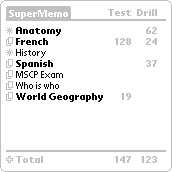 |
|
Item is the basic database element. In the built-in Address Book application, one item is one address. In SuperMemo, one item is one card with a question and answer. It can be one French word in your French database, one State/Capital pair in your World Geography database, name of one bone in your Anatomy database, etc. In SuperMemo, one database can contain up to 64,000 cards. If you want to have more than 64,000 cards, you need to split them into two or more databases.
|
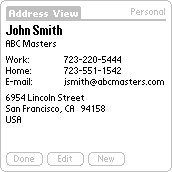 |
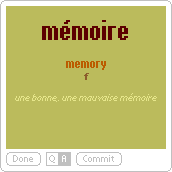 |
|
Cards in databases are organized in categories. Every card belongs to one and only one category. In the built-in Address Book example screen, you probably have categories such as Business, Personal and Unfiled. In SuperMemo, you can have separate category names within each database. In your World Geography database you can have categories such as Rivers, Cities, Capitals, US States, Mountains and Unfiled for instance. One category can contain up to 32,000 cards. Unlike the built-in Address Book and most of other applications, category names in SuperMemo can be up to 31 characters long. You can also have more than just 16 categories, which is a limit of the Address Book and most other applications. In SuperMemo, you can have up to 32,000 categories in one database. Other advantages of the SuperMemo category system include the number of category cards displayed in category lists and an ability to rename the system Unfiled category as well.
|
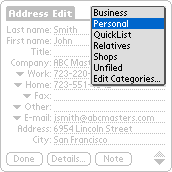 |
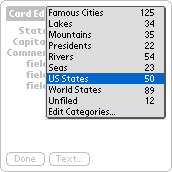 |
|
Every item (card) consists of 6 fields that you can use. In the built-in Address Book application, one address has about 20 fields such Last Name, First Name, Title, Company, Phone, E-mail, City, Zip Code etc. In SuperMemo, items have only 6 fields that you can rename as you wish. Field names can be up to 15 characters long. In your SuperMemo French database you can define fields such as English, French, Gender or Example. Fields can have different names not only in each database but in each category as well. Let's take our World Geography database. You can have fields like Name, Length and Comment in the Rivers category and you can have fields like State, Capital and Comment in the US States category.
|
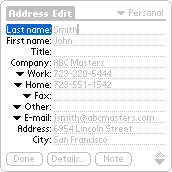 |
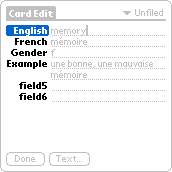 |
|
Each category in SuperMemo database has its own template. The template defines the look of all cards in its category. It defines what fields should be shown in a question and what fields should be shown in an answer. It also defines the look of the card. The template has 10 paragraphs for a question and 10 paragraphs for an answer. In each paragraph, you can define the font (Mini, Bold, Large, Italics, Outlined, Negative, Tall and Wide), text color, background color, justification (left, center or right), left and right indent and a free space above and below the paragraph. You also define the text that will be displayed in each paragraph. Any plain text that you write here will appear literally on each card. Besides the plain text, you can also use special field tags that will be replaced by the actual item field values on each card. Of course, you do not need to care about templates at all if you are content with the standard look of the cards. Whenever you create a new category, it will copy its template from the last active category. You can also copy templates from one category to another using clipboard.
|
 |
|
Cards in your database can be divided into two groups - those that are committed to the learning process and those that are not committed yet. SuperMemo does not include cards that are not committed in its learning algorithms. When you learn a card for the first time, you commit it and tell SuperMemo to take care about the card so that you do not forget it. Since then, the card will appear in your daily tests. This is also indicated by a different icon of the card in the Card List screen. When you commit a card, it will be automatically inserted into the drill for you and scheduled for the first test that will take place in a day or two. If you commit a card by accident, you can reset it so that it is not committed any more, or you can completely delete the card from your database if you want to. Databases can also be divided into those that are committed and those that are not. The database is considered committed if it has at least one committed card. A committed database has a different icon as well.
|
 |
|
The purpose of a test is to refresh your knowledge and find out how well you remember each card. Tests are the core of the SuperMemo program. Every day, SuperMemo will prepare a set of tests for you, one test per database. The ideal way of learning is to do the tests every day. If you do not finish the test on one day, the next day you will have a bigger test. It will contain new cards for the new day and unfinished cards from the previous day as well. In the test, SuperMemo will show you a question. You will try to recall the answer, then press Show Answer button and then you will rate the quality of your answer. Based on this rating and on other data kept for each card, SuperMemo will schedule the card for another test. Usually, the better your answer is, the later you will see the card in the test again. If you recalled your answer with difficulties or it was inaccurate (mark C) or wrong (marks D, E, F), the card will also be automatically inserted into the drill for you.
|
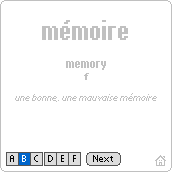 |
|
The purpose of a drill is to practice the cards you don't remember well. Drill is a kind of simplified test. Unlike real tests, which are prepared by SuperMemo only, you can prepare your own drills if you want to. Drills have no effect on your stored learning progress, they do not change any parameters of cards or tests. SuperMemo repetition spacing algorithms do not care about the drills. Drill is a just a pile of cards. You look at the question side, flip the card to see the answer and then you either remove it from the drill by rating your response Right or leave it in the drill by rating it Wrong. The cards rated Wrong will then appear in the same drill again and again until you rate them as Right.
|
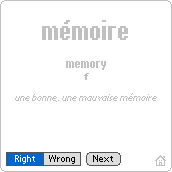 |
|
|
© MapleTop Software |
|
|